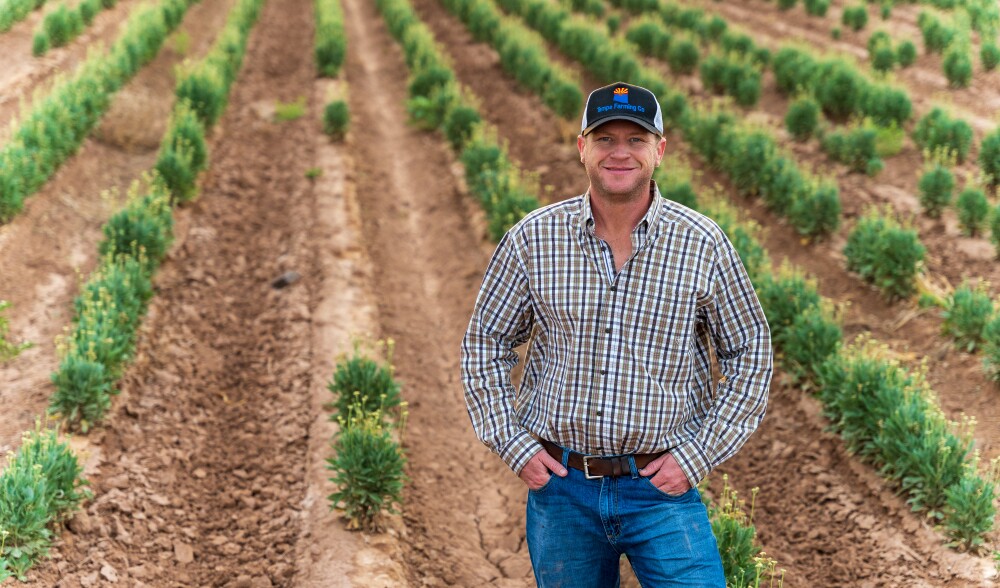The fundamentals of farming are simple – crops need water to grow.
So what happens when unprecedented drought causes water shortages and mandatory cutbacks in water available for agriculture?
It’s no longer a theoretical question in the Colorado River Basin. In Arizona, many farmers have already lost access to Colorado River water for irrigation, amid restrictions this year that cut the state’s supply by 20%.
Will Thelander is one of them.
“We were the first people to be cut from the Colorado River,” says Will, who farms 7,000 acres with his family near Casa Grande, in Pinal County. “Now we're drawing water from ground pumps – but you can only grow so much with water out of ground pumps.”
While water restrictions arrived a few years earlier than Will expected, he has – in some ways - been preparing for this moment for years.
As climate change brings ever hotter and drier conditions in the West, the third-generation farmer is planting a new crop – guayule – that uses dramatically less water than corn, cotton, alfalfa and wheat.
Little known outside the Southwest, guayule is a natural source of rubber that is seen as a potential alternative to rubber from trees in Southeast Asia.
The fibrous shrub is native to Mexico’s Chihuahuan desert, with strong deep roots. It requires about half as much water as major commodity crops that currently dominate Arizona agriculture.
Guayule’s potential has sparked a unique collaboration aimed at lessening the severity of Arizona’s water crisis, improving the sustainability of western agriculture and feeding the global demand for rubber. Will is partnering with Bridgestone and the Environmental Defense Fund (EDF) to grow guayule for seed on 75 acres of his farm.
Bridgestone, which hopes a domestic source of rubber will lessen its dependence on rubber from the hevea tree in Southeast Asia, operates its own 300-acre research and development farm, as well as a processing facility in Arizona.
“Guayule represents one of the crops we think is part of agriculture’s future in this water-stretched region,” says Kevin Moran, EDF’s Associate Vice President for Regional Affairs, who oversees the organization’s Colorado River work.
“The viability of farms in Arizona and the Colorado River Basin is at risk because of the reduced quantity of water. We’re talking about a significant portion of the economy and the region’s agricultural-based lifestyle.”
The Walton Family Foundation has supported the development of guayule as a water-saving crop alternative in the Colorado River through grants to EDF.
Guayule is a perennial crop that takes two years to grow to maturity for harvest. Unlike annual crops like corn, it does not require seeding every year – reducing tillage and carbon inputs required for operating tractors.
“Farmers are literally facing the choice of fallow fields or choosing a different crop,” says Jonathon Pesek, director of corporate strategy with Bridgestone USA.
“Guayule is a very, very low water-use crop. It regrows from the root every two years. So from a farmer perspective, it's a lot easier to manage and maintain. You're not having to reseed all the time.”
Bridgestone is hoping to begin commercial production of rubber from guayule later this decade. That would require guayule to be grown across more than 20,000 acres of farmland in the Southwestern U.S. Government and industry continue developing the plant’s genetics to enhance crop yields.
The University of Arizona, in partnership with Native American tribes and Bridgestone, recently received up to $35 million in federal funding to build a Climate-Smart Domestic Rubber Industry and a solution for farmers to the West’s water crisis.
It can be challenging for new crops to gain traction amid market obstacles and uncertainty, capital costs for farmers and time needed for crop research and development.
Will is working with Bridgestone, and EDF, to spread the word about guayule’s potential to other farmers in the region including the Tohono O’odham Nation and the Gila River Indian Community.
“There’s a lot of work on the front end, but once it's in the ground, then it can be super easy,” Will says. “What makes guayule so great is that it can stretch your water a lot farther than other crops.”
Corn, for example, can require 4 to 4.5 acre-feet of water over four to six months in a growing season. By comparison, over a twelve month period, guayule has proven to be viable at 2.5 to 3 acre-feet of water. Ongoing public and private research has goals to further reduce that amount through breeding and technology.
“If you could grow a thousand acres of corn with your current water supply, you might be able to grow 2,000 acres of guayule,” Will says.
Growing guayule on twice as many acres with the same amount or less water also brings other benefits. It uses and sequesters more carbon and also reduces wind erosion.
For Kevin Moran at EDF, guayule represents one solution in a bushel of solutions needed to protect water resources and agriculture in the Colorado River Basin.
If farmed at a large scale, guayule could save about 15% of the current water being used for agriculture in Pinal County, EDF says.
“Crop switching is among a number of strategies required for the region to adapt,” he says.
“Farmers in the sun corridor between Phoenix and Tucson are losing roughly 55% of the water they've been using to grow crops. The water crisis is here and it’s not going to be solved without all sectors – including agriculture - reducing water demand and what we take from the river.”




